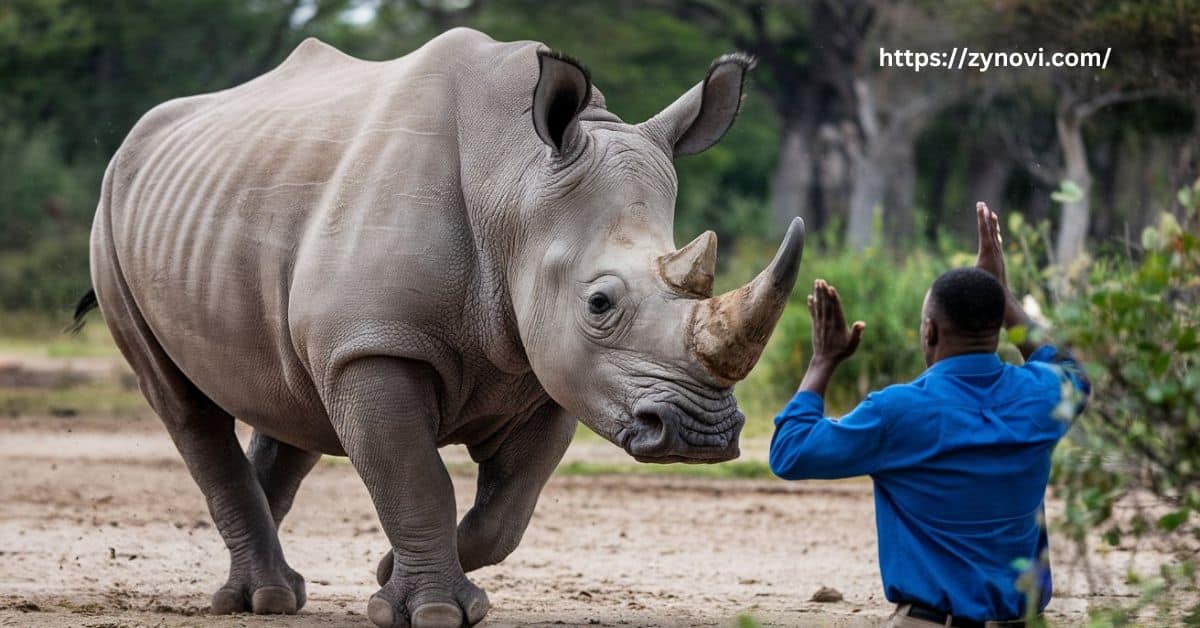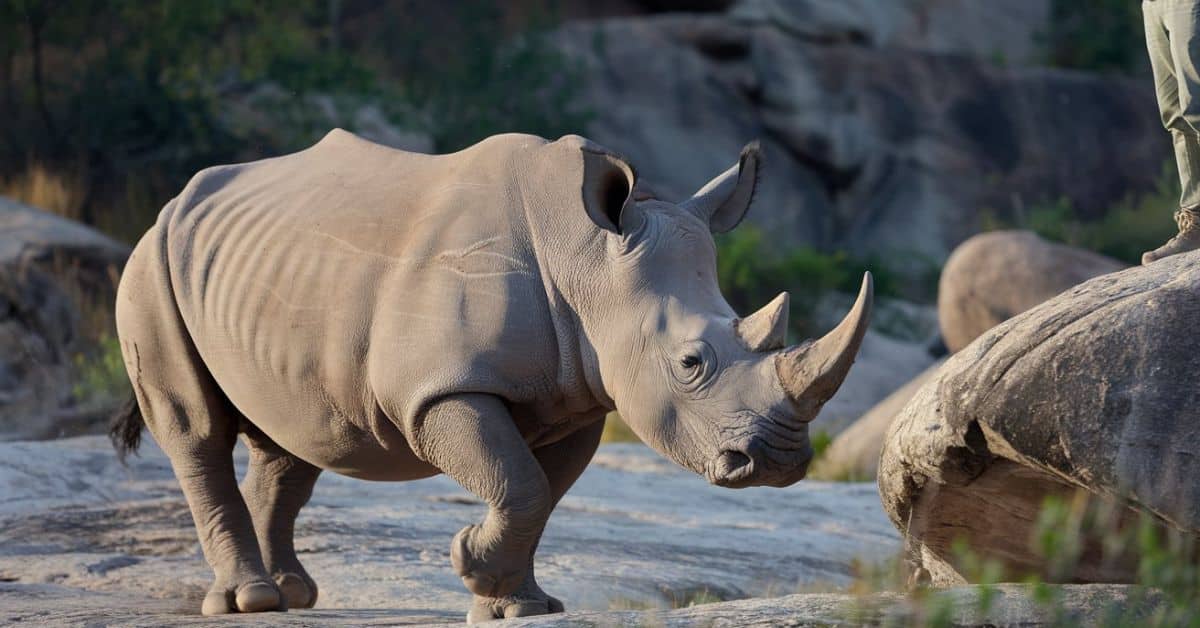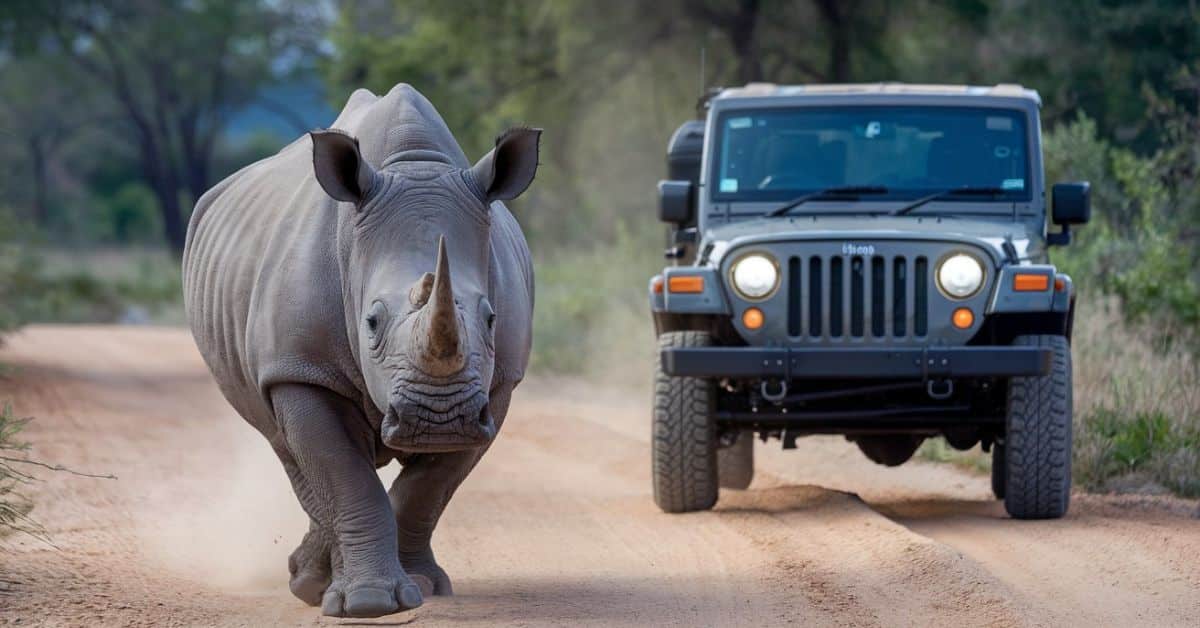Do rhinos attack humans? Rhinos typically avoid humans but may become aggressive if they perceive a threat or feel cornered.
It’s a question many safari-goers and wildlife enthusiasts wonder about before venturing into rhino territory. While these majestic creatures are generally peaceful herbivores, they can become surprisingly dangerous if they feel threatened or startled. The truth is, understanding their behavior and knowing how to act around them can make all the difference in staying safe.
In this article, we’ll explore when and why rhinos might charge, the key warning signs to watch for, and how you can protect yourself during encounters. If you’ve ever been curious about these powerful animals, keep reading to learn more about their fascinating, yet potentially risky, nature!
Understanding Rhinos
Overview of Rhino Species
Rhinos, or rhinoceroses, are large, odd-toed ungulates known for their thick skin and distinctive horns. Rhinos are powerful and majestic creatures, Understanding rhino behavior, warning signs, and safety measures is crucial, especially for those visiting safari parks or wildlife reserves.
There are five species of rhinos, each with unique characteristics and habitats:
| Rhino Species | Location | Key Characteristics |
|---|---|---|
| White Rhino | Africa (South Africa, Namibia, Zimbabwe) | Largest species, broad mouth for grazing |
| Black Rhino | Africa (Kenya, Tanzania, Namibia) | Smaller, hooked lip for browsing |
| Indian Rhino | India, Nepal | Armor-like skin, single horn |
| Javan Rhino | Java, Indonesia | Rare, elusive, also single-horned |
| Sumatran Rhino | Indonesia, Malaysia | Hairy rhino, smallest species |
Natural Habitats and Distribution
Rhinos thrive in diverse ecosystems, from the vast African savannas to the dense tropical forests of Asia. Their natural habitats include grasslands, woodlands, and swampy areas, providing ample food and cover.
As herbivores, they graze on grasses, leaves, shoots, and fruit, shaping their environments while maintaining delicate ecological balances.
Behavioral Traits and Social Structure
- White rhinos are known for their social nature, often found in small groups that typically consist of females and their offspring. Males may join these groups temporarily but tend to be more solitary as they mature.
- Black rhinos and Asian rhinos, on the other hand, are mostly solitary animals. These species are highly territorial, with males and females maintaining separate ranges that they defend from other rhinos.
- All rhino species, regardless of their social structure, use scent marking to establish and defend their territories. They do this by rubbing their bodies on trees, rocks, and other surfaces to leave behind a scent that signals their presence to other rhinos.
Do Rhinos Attack Humans?

Are Rhinos Naturally Aggressive?
Rhinos are not inherently aggressive toward humans, but their behavior can be misunderstood due to their poor eyesight. They rely much more on their senses of smell and hearing to navigate the world around them.
If they sense an unfamiliar presence or perceive a threat, they may react defensively, charging or becoming more alert. These responses are not out of aggression but are simply their instinctual way of protecting themselves.
Documented Cases of Rhino Attacks
Do Rhinos Attack Humans? Documented cases of rhino attacks on humans are rare but not unheard of. These attacks typically occur when humans unknowingly enter the rhino’s territory, causing the animal to feel threatened or cornered.
In such situations, the rhino may react with a defensive charge, using its size and power to protect itself. Despite their generally calm nature, rhinos can become aggressive if they perceive danger.
Comparison with Other Large Mammals
| Animal | Speed | Aggression Level |
|---|---|---|
| Rhino | 30-40 mph | Charges when threatened |
| Elephant | 25 mph | Can be territorial |
| Hippo | 20 mph | Extremely aggressive |
| Buffalo | 35 mph | Unpredictable, highly dangerous |
What Triggers a Rhino Attack?
Do Rhinos Attack Humans? Here are some points discuss about that how they triggers attack
- Territorial Defense and Instincts: Rhinos are highly territorial animals, and males, in particular, are known to aggressively defend their space. They perceive intruders, whether human or animal, as threats and will charge to protect their territory from perceived dangers.
- Startling and Sudden Movements: Due to their limited vision, rhinos are easily startled by sudden movements or loud noises. When they are surprised in this way, they may react defensively, sometimes charging or becoming aggressive to protect themselves.
- Motherly Protection: Rhino mothers are fiercely protective of their young calves. If they sense any potential danger, whether from predators or humans, they will charge without hesitation to defend their offspring, using their size and strength to ward off threats.
- Provocation and Human Encounters: Aggressive rhino behavior can occur in situations where they feel provoked, such as during safaris, poaching attempts, or illegal land encroachment. These stressful encounters can cause rhinos to act out of fear or frustration, leading to aggressive reactions.
Types of Rhino Attacks
- Defensive Charges vs. Predatory Behavior: Rhinos are herbivores and do not engage in hunting. Their charging behavior is purely defensive, triggered by perceived threats to themselves or their territory.
- Warning Charges vs. Full-Blown Attacks: Rhinos sometimes perform mock charges, running towards a threat and stopping just before impact to warn them off. In more serious situations, they may launch actual attacks, using their horns to gore or overturn perceived dangers.
- Fatal vs. Non-Fatal Encounters: Most rhino attacks on humans are non-fatal, with victims surviving by fleeing or climbing to safety. Fatalities are rare but can occur if the person cannot escape in time or is caught off guard.
Are Rhino Attacks Deadly? Assessing the Risk

Rhino Strength and Speed: Both white and black rhinos are capable of reaching speeds of 30-40 mph, despite their large size. This surprising speed allows them to charge quickly if they feel threatened.
Rhino Protection: Rhinos have thick skin that provides some protection against predators and environmental factors. However, while it’s tough, it doesn’t make them invincible, and they can still be vulnerable to injuries or attacks.
Case Studies of Fatal vs. Non-Fatal Attacks
- Case Study of Non-Fatal Attack: In 2022, a tourist in Namibia survived a black rhino charge by remaining still and avoiding any sudden movements. The rhino, after a brief warning charge, lost interest and moved away, allowing the tourist to escape unharmed.
- Case Study of Fatal Attack: In 2018, a poacher in Kruger National Park was tragically killed by a rhino after being cornered. The rhino charged and gored the poacher, who was unable to escape in time, leading to a fatal encounter.
Medical Consequences of a Rhino Attack
The medical consequences of a rhino attack can be severe due to the animal’s size, strength, and powerful charge.
Victims may suffer broken bones from being struck or knocked down, deep gashes from the rhino’s horn, or internal trauma caused by the impact.
The force of the attack can lead to life-threatening injuries, requiring immediate medical attention.
How to Prevent From Rhino Attack
- Best Practices for Tourists and Safari-Goers: Always stay inside vehicles while on a safari, as exiting can put you at risk. Additionally, maintain a safe distance of at least 50 meters from rhinos to avoid startling or provoking them.
- How to React if a Rhino Charges: If a rhino charges and you’re far away, remain still and avoid running, as sudden movement may trigger its pursuit instincts. If the rhino is close, running in a zigzag pattern may confuse it, and climbing a tree or finding a large obstacle can provide protection.
- The Role of Park Rangers and Guides: Always follow the instructions of park rangers and guides, as they are experienced in safely navigating rhino habitats. Never approach or attempt to feed rhinos, as this can provoke them or encourage dangerous behavior.
Conservation Efforts and Human-Rhino Coexistence

The Impact of Poaching on Rhino Behavior
Poaching for rhino horns has significantly impacted rhino behavior, particularly in areas with high poaching rates. The constant threat from humans has caused increased aggression in some populations, as rhinos become more defensive and wary of their surroundings.
This heightened stress and defensiveness may lead to more frequent territorial disputes and defensive charging behaviors, making them more unpredictable and dangerous.
Conservation Projects Protecting Rhinos
| Organization | Efforts |
|---|---|
| Save the Rhino | Anti-poaching patrols, habitat restoration |
| WWF | Rhino conservation programs in Africa and Asia |
| IRF (International Rhino Foundation) | Focuses on Sumatran and Javan rhino protection |
Ethical Tourism and Wildlife Protection
- Ethical Tourism and Wildlife Protection: Support ethical safaris that prioritize non-intrusive observation of wildlife. These safaris ensure that animals, like rhinos, are not disturbed or exploited, promoting conservation efforts and sustainable tourism.
- Avoid Buying Rhino Horn Products: Avoid purchasing rhino horn products to help reduce demand and discourage poaching. By not contributing to the market for illegal wildlife products, you play a role in protecting rhinos from exploitation and harm.
FAQs
What to do if a rhino is chasing you?
If a rhino is chasing you, try to find a large obstacle or tree to hide behind, or climb to safety if possible.
How aggressive is a rhino?
Rhinos are generally not aggressive but can become dangerous if threatened, startled, or protecting their territory or young.
How common are rhino attacks?
Rhino attacks on humans are rare, but they can occur if humans accidentally invade their space or provoke them.
What do you do if a rhino charges at you?
If a rhino charges, remain still if far away, or run in a zigzag pattern if close to confuse the rhino and escape.
Conclusion: Do Rhinos Attack Humans?
Rhinos are not inherently aggressive toward humans, but they can become dangerous when they feel threatened, startled, or are defending their territory. Their natural instincts for self-preservation and protection of their young or territory can lead to defensive charges or aggressive behavior, especially when they perceive humans as intruders.
To minimize the risk of an attack, it is essential to respect their space, avoid sudden movements, and follow established safety guidelines during safaris or encounters. Additionally, supporting conservation efforts to protect rhinos and reduce poaching can help ensure their survival and reduce human-wildlife conflicts.










